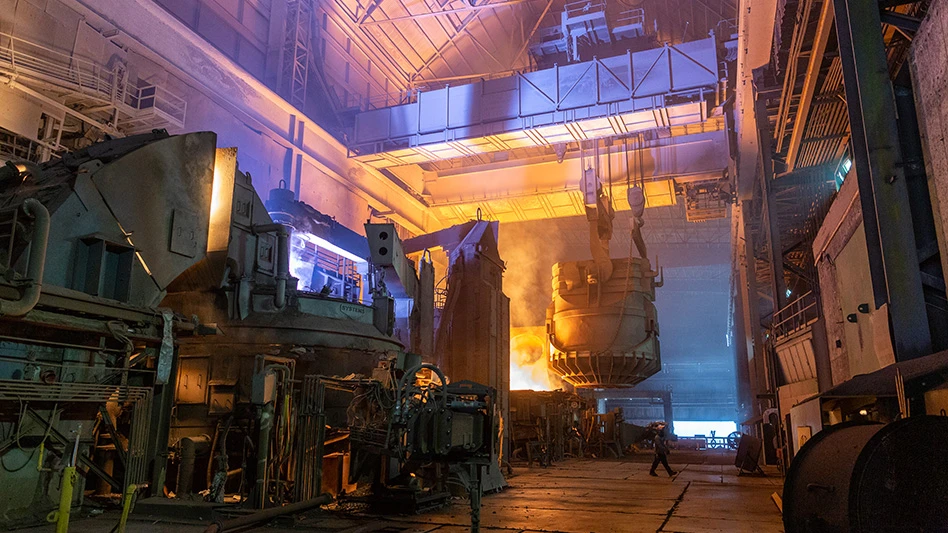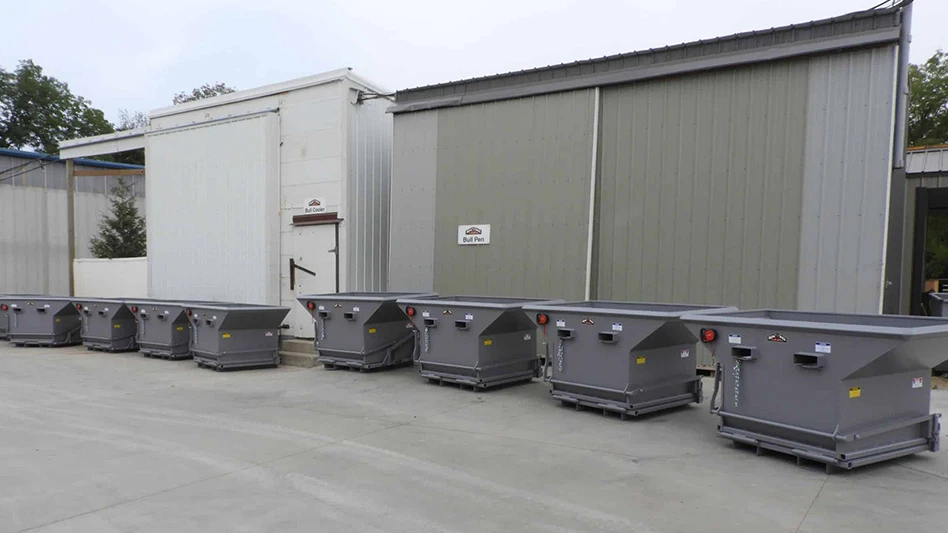The expectation of scrap recyclers just a year or two ago was that the strongest bull economy in history would bring peace and prosperity to the entire industry. This confidence, among other things, ushered in the “shredder boom” of the 1990s, when increasingly larger shredders produced more and more ferrous shred. In the United States, more than 200 shredder operators anticipated processing record amounts of scrap through the end of the century to meet the demand of a red-hot economy.
Unfortunately for scrap recyclers, the shredder boom collided with the Asian bust. What started out as the Asian flu quickly became the Asian plague. American scrap was no longer welcome in Asia as one nation’s economy after another collapsed under the weight of corruption, inept financial practices, archaic banking laws, political despotism, cronyism, or some combination of all these factors. Economic malaise spread to Russia, South America and Europe.
The scrap recycling industry was hit hard. As imported steel washed up on American shores, steel mills here cut their demand for scrap. At the same time, scrap export markets disappeared, sending scrap from the coasts pouring into the heartland. As the scrap supply climbed and demand dropped, prices plummeted. Shredder operators began (and still are) scrambling to keep their facilities operating efficiently and profitably. Amidst this background, Recycling Today took the pulse of shredder operators around the country. Here’s what they had to say.
POOR MARKETS
“Markets are so poor, it’s been hard moving the product,” says Adam Weitsman, vice president/general manager, Upstate Shredding LLC, a division of Ben Weitsman & Son, Owego, N.Y.
“Market conditions have changed operations dramatically,” adds Frank Cozzi, president of Cozzi Iron & Metal, Inc., Chicago. “The market has gone down more than 40%. It’s been difficult to attract tonnage.”
Shredder operators universally share these views. “90% of shredders in the U.S. are underutilized,” says Joel Denbo, executive vice president, Denbo Iron & Metal Co., Inc., Decatur, Ala.
With scrap prices so low, shredder operators are losing their peddler or “alley entrepreneur” trade. It’s no longer profitable for peddlers to scour the city and countryside for scrap. The result is a diminishing amount of old appliances and other material finding its way on to most shredders’ conveyor belts.
“Alley entrepreneurs simply are not going to pick up scrap for $25 per ton,” says Cozzi.
Why most shredders and not all? An interesting phenomenon has crept into the shredder economics equation. In order to keep tonnage up, some shredder operators are paying artificially high prices for peddler scrap, according to the president of a Midwest scrap facility who wishes to remain anonymous.
Kevin G. Gershowitz, executive vice president, Gershow Recycling, Medford, N.Y., also points out that some shredder operators are boosting the price they’ll pay for scrap in order to keep their shredders operating. He emphasizes, however, these operators are being further victimized by the unfavorable markets by following this strategy to maintain tonnage. “It’s very difficult for any shredder operator to make a buck,” Gershowitz adds.
Complicating matters is the number of shredders that keep coming on-line.
“There are so many shredders coming into the market that the competition for scrap will continue to be amazing,” says Weitsman.
Commenting on the number of shredders in the marketplace, Mitchell Padnos, vice president of marketing, Louis Padnos Iron & Metal Co., Holland, Mich., says “it’s a free enterprise system and the capitalist way. We will all need to figure out how to work with this.”
The impact of so-called super-sized shredders on scrap supply remains in dispute. There is no doubt these machines need a lot of scrap to run efficiently. Super shredders can process about 250 tons of scrap per hour compared with the 60 to 100 tons of their smaller relatives. However, the way in which they compete for material may be a function of their location.
Marty Wilhelm, president, Youngstown Iron and Metal Inc., Youngstown, Ohio, believes their impact may be acutely felt in areas in which they are found.
Gershowitz notes that super shredders brings about certain efficiencies to operations. But he argues no matter what the shredder size, if there are ten people looking for scrap instead of eight, the scrap is going to be harder to find and it will be pricier.
HOARDING AUTOS
The “meat and potatoes” feedstock for shredders is crushed auto hulks. But auto dismantlers, seeing the price of scrap staying in the lower levels of the atmosphere, are hoarding automobiles.
“Auto wreckers will sit on loads for years at a time,” says Marty Wilhelm. “I know one auto wrecker who is holding on to 150 truckloads.
“Car bodies tend to be price elastic. When the price for them goes up, more come in to the shredder. When the price goes down, we see less of them,” he adds.
The situation hasn’t reached the point where automobile hulks are lining the sides of America’s roads, but “auto dismantlers are looking at this situation as a chance to lay down inventory and wait,” says Padnos.
GLOBAL COLLAPSE
Without exception, those whom Recycling Today spoke with blamed global economic forces for the hard times confronting shredder operators.
“The Asian situation has hurt the industry badly,” says Weitsman. “We’re in an oversold market.”
Exacerbating the situation is the dumping of steel in the U.S. by Asian countries and Russia. Cheap steel has crippled the demand for ferrous scrap by consumers. U.S. steel mills are seeing their orders dry up in the face of this onslaught of foreign steel. In the third and fourth quarters of 1998, U.S. steel mills began a wave of layoffs and shutdowns.
“One reason the price of scrap is down is because mills aren’t running,” says Padnos.
“Our customers are suffering,” adds Denbo. “They’re in dire straits. As long as our customers suffer, we can’t help but suffer.”
Just how bad are things in the steel industry? According to the Steel Recycling Institute (SRI), Pittsburgh, U.S. steel production is down more than 20%, resulting in thousands of layoffs.
“Steel scrap is a key ingredient in the steelmaking process,” says SRI president William M. Heenan Jr. “If unrestricted foreign imports continue, we will see a build-up of scrap inventory across the country.”
SRI has joined the industry-wide “Stand Up For Steel” campaign, a grass roots effort to put pressure on President Clinton to enforce trade laws against foreign dumping of steel.
As Recycling Today was going to press, the federal government began discussions with Japan, Russia and other major steel exporters to address the surge of steel imports into this country. The U.S. was seeking “voluntary restraints” from these countries as opposed to initiating import quotas, which would be a violation of World Trade Organization rules.
Intervention into the steel dumping fray by the Clinton Administration can’t come soon enough.
“There is so much dumping of steel it’s killing the mills,” says Weitsman. “The government has to step in before the mills go by the wayside.”
OTHER ISSUES
Shredders don’t operate in a vacuum and scrap recylers still must contend with the same issues whether the times are good or bad. Transportation and environmental issues top the list.
“Everything in scrap is a function of freight,” says Youngstown Iron and Metal’s Wilhelm. “The key is doing it efficiently and cost-effectively.”
“Transportation is always a huge part of the puzzle,” says Denbo. “Costs are still escalating. Transportation is a major capital investment.
Cozzi points out the shortage of truck drivers is a national problem and scrap facilities must compete for them at the highest rates. He still argues there are seasonal issues when shipping by rail or barge and maintains there is still a gondola car shortage.
“There never seems to be enough equipment when everyone is shipping scrap,” says Cozzi.
For those who have port or river access, over-the-water shipping rates provide an extremely affordable option. While this is a benefit to some scrap processors, it can also make for some strange logistic situations. For example, Padnos points out, for some mills it can cost less to bring in scrap from the port of Rotterdam than to have it shipped in domestically by rail.
ENVIRONMENTAL CONCERNS
Whereas environmental issues will continue to demand the attention and resources of shredder operators in the years ahead, the industry is staying ahead of the curve in meeting federal, state and local regulations.
“Shredder operators are environmentally conscious and aware,” says Wilhelm.
Gershowitz seconds this point of view. “Scrap recyclers have to comply with environmental regulations if they want to stay in business.”
It is unlikely the attention given to the industry by environmental regulators will lessen in the years ahead.
“As time goes on, enforcement people and regulators will become even more aware of the scrap industry,” says Cozzi. “I don’t see it lessening.”
HOW TO COPE
Given rocky times will be with the scrap recycling industry for at least the foreseeable future, what strategies might shredder operators adopt to stay afloat?
“We continue to expand,” says Weitsman. “We plan to add a feeder yard to our operations. We want to control our own destiny and not just rely on auto bodies. We want to establish a network of feeder yards within a 150-mile radius.”
Weitsman points out that Upstate Shredding is looking for sources of light iron. There is less waste than that found with shredding auto bodies. He also points out non-auto body sources yield a better nonferrous recovery.
“Auto bodies come with a lot of glass and plastic that must be disposed of as auto shredder residue (ASR) in a landfill,” he says.
Padnos notes shredder operators may have to operate on different schedules than in the past.
“We’re operating at 40% to 50% of capacity,” he says. “It’s a good time to do maintenance.”
“Every shredder operator is trying to tweak their machines to get as much tonnage out as possible,” says Gershowitz. He adds that Gershow Recycling is always looking for new sources of scrap.
“Scrap always finds itself a home,” says Gershowitz. “If you don’t look for it and direct it to your facility, it will wind up elsewhere.”
Sidebar
Going Plastic
The changing composition of automobiles is starting to impact shredder operations and economics. Although most cars shredded today are more than five years old, shredder operators will soon start to see automobiles with more nonferrous and nonmetallic content, or both.
The increase in the amount of plastic will add to the cost of disposing of auto shredder residue (ASR), says Joel Denbo of Denbo Iron & Metal Co. Inc. in Decatur, Ala.
Upstate Shredding’s Adam Weitsman agrees. “Landfill fees for shredder residue are rising,” he says. “At the same time, nonferrous prices are one-half of what they were two years ago and ferrous prices are one-half of what they were one year ago.”
With more aluminum going into cars, it’s a virtual certainty that auto dismantlers will hold on to the valuable aluminum.
Dr. Richard Burlingame, a Cleveland-based consulting metallurgist, points out that auto dismantlers will keep the aluminum engines and power train components that are replacing cast iron parts at an increasing rate. As a result, the shredder operator will not only lose all this aluminum, but he will also lose several hundred pounds of cast iron from each hulk.
Further, Dr. Burlingame notes whereas eddy current separators and heavy media separation systems are adept at recovering nonferrous metals for shredder operators for a profit, nonmetallics remain a problem.
“Nonmetallics or fluff will go up in volume,” says Dr. Burlingame. “The increase has not peaked yet.”
There is another side to the ASR coin. Mitchell Padnos of Padnos Iron & Metal, Holland, Mich., looks at how ASR should be handled as a challenge to the industry. The industry, he says, needs to find ways to recycle ASR in different ways, rather than ship it to landfills. Opportunities lie in finding either energy uses for ASR or devising ways to make products from the material.
Sidebar II
A Matter of Quality
It’s a buyer’s market. One consequence of the collapse of the scrap export market to Asia and the dumping of steel onto U.S. shores is American scrap consumers are being very choosy.
“Mills’ quality standards have definitely gotten stricter,” says Adam Weitsman, vice president/general manager, Upstate Shredding LLC, a division of Ben Weitsman & Son, Owego, N.Y.
“Consumers can be a lot more demanding about the scrap they purchase because they have many sources from which to buy it,” adds Dr. Richard Burlingame, a Cleveland-based consulting metallurgist.
Of particular interest to Dr. Burlingame is how super shredders will figure into quality issues. One of the purported advantages of super shredders is their ability to reach into categories of scrap that weren’t shredded before. This includes No. 1 and No. 2 heavy melt scrap. The two plusses, notes Dr. Burlingame, are (1) the super shredders will produce scrap with a significantly higher bulk density than that produced by shredding auto hulks alone, and (2) a measurably higher melting yield should be obtained by the consumer who uses shredded scrap containing a high percentage of No. 1 and No. 2 heavy melt.
The downside of using No. 1 and No. 2 heavy melting scrap is that the levels of tramp elements, particularly copper, nickel, chromium, tin and molybdenum, will increase, says Dr. Burlingame.
In the final analysis, shredder operators must continue to find ways to improve the quality of scrap they send to consumers.
“Steel mills want to improve their own operations,” says Kevin G. Gershowitz, executive vice president, Gershow Recycling, Medford, N.Y. “They’re constantly looking for suppliers who can provide consistently good scrap.”
Sidebar III
European Shredder Operators Face Trade, Regulatory Questions
For much of the 1990s, European scrap metal processors (and especially those who export) have had to wonder what new regulatory hurdle or international trade restriction might face them next.
With cross-border trading common to almost every shredder operator, the machinations of international trade treaty conventions have been watched very closely by the European ferrous scrap community.
In the late 1990s, the Bureau of International Recycling (BIR), Brussels, and other trade groups spent much of their energy lobbying the European Union and delegates of the Basel Convention. These international bodies each considered legislation or treaty language that presented potential hurdles to the international trade of scrap metal and other recyclables.
While the matter is far from settled, a British High Court decision rendered in late 1998 seemed to favor the possibility that many of the potential barriers to free scrap flow will not stand indefinitely. In the November decision, the court ruled that processed ferrous and nonferrous scrap—including ferrous shred—was a raw material and not waste. “This judgment provides an important legal precedent that I trust the European Commission will recognize," BIR president Anthony Bird said after the ruling.
It was a welcome victory for British shredder operators in particular, who earlier in the year had faced unwelcome scrutiny from a national government minister. Treasury Minister Alistair Darling was ridiculed by the British Metals Federation and others for his suggestion that shredder operators could avoid a landfill tax on auto shredder residue (ASR) by more carefully sorting through their fluff to separate out organic soil and stones that could be landfilled without being subject to the ASR tax. Critics contended Darling’s suggestion revealed an ignorance on his part of the industry’s profit structure.

Explore the January 1999 Issue
Check out more from this issue and find your next story to read.
Latest from Recycling Today
- Autocar releases Smart Battery Cable to advance refuse truck fire safety
- PLASTICS launches Positives of Plastics website
- Impact Air Systems launches compact ZAC400
- PCA to shut down paper machines at Washington containerboard mill
- BMRA provides landfill guidance for UK shredder operators
- Fornnax high-capacity tire recycling plant
- EU introduces measures to secure raw materials, strengthen economic security
- US Steel to restart Illinois blast furnace





